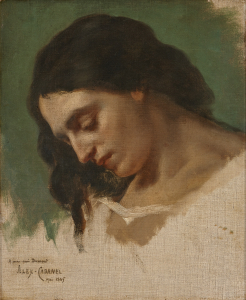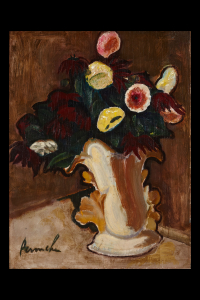Anselm Feuerbach (1829-1880)
Anselm Feuerbach (1829-1880)
View of Subiaco
This painting in warm yellows and browns presents a view of the village of Subiaco, just outside Rome, with a prominent rock formation in the foreground. The sunlit rocks precariously overhang a dark chasm, seemingly held in place only by the twisting roots of a tree that grows behind the formation. The remainder of the tableau occupies the background. On the left-hand side of the painting, we see a few buildings, part of the village of Subiaco; above them and to the right of the tree, a number of cypress trees stand upon a hill.
Anselm Feuerbach was born in Speyer in 1829, and began his training at the academy of fine arts in Dusseldorf before moving on to the academy in Munich. He continued his studies in Antwerp, in the workshop of the Flemish history painter Gustave Wappers. Working primarily in the style of the old masters, he achieved some fame as a portrait painter. In 1855, Feuerbach left for Italy, finding his way to Rome via Venice and Florence. From this point on, his work was characterised by a classicist style, with strong influences from Michelangelo and Raphael. Feuerbach was known for his misanthropic attitude; although his works were desired by collectors in the highest social circles, he suffered from a perceived lack of acknowledgement. This may have had something to do with the classicist style that he favoured: due to the rapid rise of impressionism during this time, his works rapidly went out of fashion.
Feuerbach created this rock formation painting shortly after his arrival in Rome. In Jürgen Ecker’s oeuvre catalogue (published in 1991), the work is compared to another painting dating from 1857, which also features rock formations. Herman Uhde-Bernays’s 1913 treatise claims that the painting was created in 1856. In view of the scene’s autumnal atmosphere and the fact that Feuerbach did not arrive in Rome until 1856, this would mean that he must have painted it in autumn of that year.
Despite the painting’s warm and inviting colour scheme, the tableau is somehow disconcerting. The view of the village is largely blocked by a large rock formation, suspended precariously above a deep chasm. This peculiar landscape may be interpreted as a reflection of Feuerbach’s mood. At the time of his arrival in Rome he was suffering from syphilis and undergoing treatment. Various elements in the painting are suggestive of impending doom: aside from the perilously positioned rock, there are the strangely contorted roots, as well as the cypress trees in the background. Due to their presence in depictions of paradise, cypress trees are associated with the transience of life on Earth and the hope of life after death.
Literature:
Hermann Uhde-Bernays, Feuerbach: des Meisters Gemälde in 200 Abbildungen — Klassiker der Kunst in Gesamtausgaben, Band 23: Stuttgart, Berlin, 1913, p. 167, afb. 144
Jürgen Ecker, Anselm Feuerbach; Leben und Werk, München, 1991, p. 168-169, afb. 253
- Provenance
- Private collection, Rome
Fritz Gurlitt art dealership, Berlin
Private collection, Germany - Period
- 1856
- Material
- oil on canvas
- Signature
- Monogrammed: AF (woven) [bottom right]
- Dimensions
- 48 x 36 cm
Global shipping available









